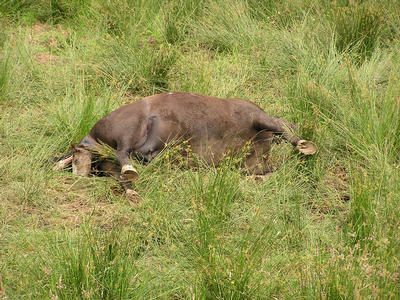
This is an adjunct to the chronicle of my family's bicycle tour through the northwest and Paula's continuation beyond Montana. If you came here via a Web search, you might want to back up to the index page to start with the overview.
In many ways, bicycling is a great way to travel through scenic areas. You can cover much more distance per day than walking, yet you stay intimately connected to the environment. Hikers can cover "better" terrain, but I've bicycled on some wonderful roads. Busier roads have a couple problems. First, that's where the roadkill is, second, that's where the trailer-pulling RVs are.
Eww, roadkill!? Well, why not? It's much easier for a bicyclist to stop to get a photo of something interesting than it is for a motorist. Heck, virtually all roadkill is due to motor vehicles. If this page offends you, especially the bottom part, I suggest you sell your car and buy a bicycle or go visit the wildlife page (even though it has birds of prey).
Few plants are roadkill, except when the road was built. Every so often a tall truck prunes a tree that is growing into the roadway, Every so often, the Oregon highway department sprays herbicide on blackberry canes that grow toward open space.
Animals that fly, crawl, or run are common roadkill. Several times we could smell but not see recent kill. That's okay, we saw more than enough!
People die on the road too, but newcasters don't call them roadkill. We used to refer to the carnage on our highways. Before seatbelts and air bags, post-holiday news had a report on the national death toll. Bicyclists are sensitive to the risk on the road. Being passed by a boxy RV or semi is easy - by the time you see it you know it won't hit you. Vehicles pulling boats are more exciting - when the bow passes you, you have time to wonder just how wide the boat is but don't have time to react. Fortunately none passed us that were "too big."
 |
We were bicycling along a quite road south of Astoria OR and rode by a farm that had a small herd of steers. This one was well deceased. While I was taking its picture and wondering why it was there, the rest of the ambled toward me and their dead compatriot. Very strange. Why was this steer dead? Why was it still there? Do I want to eat the others? |
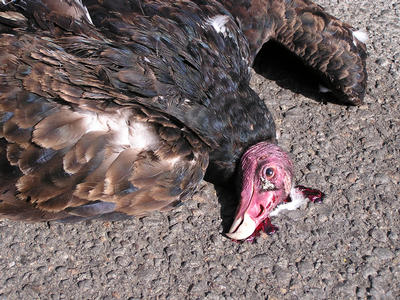 |
A few days later I passed this vulture in the middle of the road. I had never seen vulture roadkill before. Even more weird, there were other vultures wheeling around overhead looking rather uncertain if they should drop down and eat their old companion. |
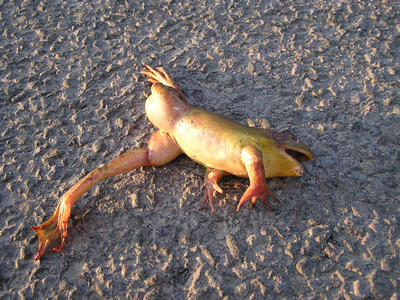 |
I like frogs, and am disappointed to see flattened frogs. This one isn't flat yet and looks like it's still striving to reach its goal. |
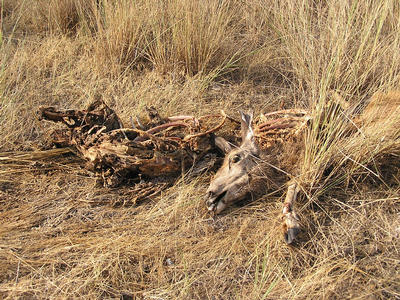 |
We passed several deer carcasses in various states of decay. We passed a freshly killed fawn one day, but I didn't stop. This one was considerably less fresh. |
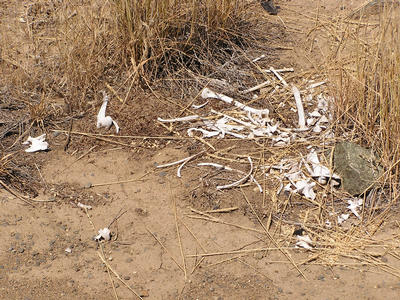 |
In the Oregon desert, several were bleached white like these scattered bones. |
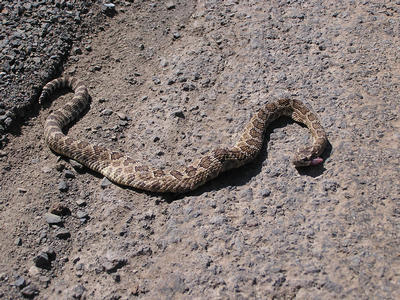 |
Snakes like to sun themselves on warm pavement. Unfortunately, they haven't figured out the downside. The only rattlesnakes we saw were roadkill and sometimes road-mortally-injured. Ask me about the black snake my brother put in his lunch pail one Friday coming home from school with thoughts of nursing it back to health. Mom found it on Monday. |
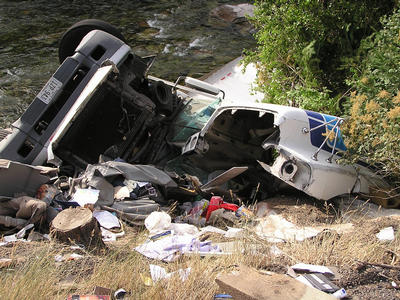 |
We camped off a riverside access road one night. The next morning
we came across this fatal crash site just a few hundred feet from
where we camped. It took me several seconds before I realized it was
a tractor-trailer truck. The crash occurred around midnight, we slept
through the whole affair! A rather unnerving way to start the day. I
never did find a news story about the crash. The riverside road is
curvy enough to keep drivers awake, but no sharper here than anywhere
else. The crash scene made a significant impression on us, so it
deserves an impression here.
I considered abandoning the roadkill page that morning, but I thought of the Harry Chapin song "30,000 Pounds of Bananas" about a fatal truck crash in Scranton Pennsylvania. He tried but failed to write a serious ending, and wound up writing a couple humorous variants. |
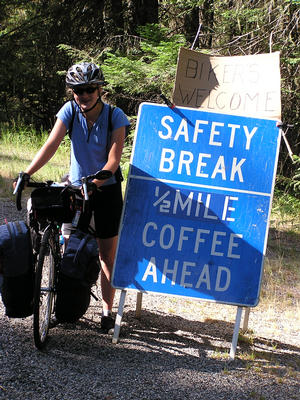 |
Later that day we pass this sign. They should have been out at midnight. |
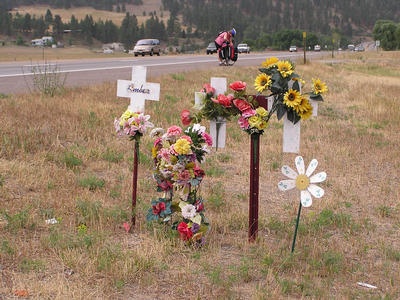 |
We passed a lot of roadside crosses. Unlike home, several appeared to have identical construction. Apparently Montana has (had?) a program to erect them after fatal crashes to remind people of dangerous stretches of road. This one is between Lolo and Missoula, a busy and fast stretch of road, one I was quite relieved to leave at the outskirts of Missoula. |
In Corvallis Oregon, we chatted with a solo cyclist from Kansas. He commented on seeing RVs towing a vehicle towing a boat and lamented that any random person can drive that combination. He has a commercial license, and he can't drive something like that without additional training. We were passed by a couple of these combinations ourselves. Given that we can spend weeks on the road with gear that fits on a bicycle, a big RV seems like it's more hassle than its worth. I wonder how many people can back up one of these triples.
Just outside of Great Falls and a few days before Paula rode through, a pickup pulling a camper pulling a boat flipped, killing two of the three people in it. The truck cab was crushed, and only the camper's wheels were recognizable in the wreckage.
Paula passed the site on the first day of her solo riding - and was passed by two semis who never left their lane to give her more room.
End of Ric's editing.
The balance of the trip was Paula's solo trip.
It was interesting to see how the roadkill changed as I headed
east. As I headed east and the desert gradually changed to
semi-arid famrland, and then the more eastern US like farm and forest,
of Minnesota, Wisconsin, and Michigan, the roadkill changed as
well.
 |
This dead hare was in N. Dakota - somewhere in the western half of the state, so it was still typical plains geography. |
| This colorful bird was a common roadkill all through eastern Montana and N. Dakota. I'm not a bird expert, obviously. Miniature pheasant? |  |
 |
A nice green frog is a sign of the wetlands I was approaching in Minnesota. This was where the air was starting to smell more like wetlands than desert. I could tell I was finally getting east when I started running into load of these all over the roads. He was only about 2" long. I guess he's not dead, either, but loads of them were. It was interesting to see how well camoflauged they were on the road. |
| This fat racoon was typical of Minnesota and Wisconsin. A lot of farms, a lot of corn, and a lot of healthy racoons - and some that only meet their demise crossing the road for better pickings. |  |
Other links: